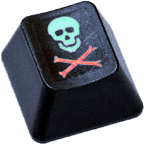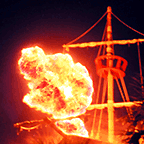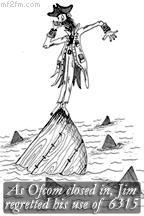Wednesday 21 January, 2009, 16:56 - Pirate/Clandestine
 Various forums and logging sites around the web have reported that short-wave pirate station Premier Radio International was recently raided. Their transmitters and studio equipment were apparently taken. Premier Radio operated on 6265 kHz on Sunday mornings from Ireland and according to the reports the Irish spectrum regulator, ComReg, received a complaint of interference from the UK spectrum regulator Ofcom which forced them into action.
Various forums and logging sites around the web have reported that short-wave pirate station Premier Radio International was recently raided. Their transmitters and studio equipment were apparently taken. Premier Radio operated on 6265 kHz on Sunday mornings from Ireland and according to the reports the Irish spectrum regulator, ComReg, received a complaint of interference from the UK spectrum regulator Ofcom which forced them into action.Such a raid on pirate broadcasters is not unheard of, though a 'cease and desist' letter is often sent to the operator first to warn them that they are at risk of being 'boarded'. Short-wave stations, however, are raided much less frequently than their FM pirate counterparts who lose transmitters on a regular basis. One of the reasons for this is that it can be much more difficult to identify the location of a short-wave transmitter. The other is that interference tends to be caused outside the country in which the transmitter is located - hence the need for the collaboration between Ofcom and ComReg.
There are, however, many short-wave pirate stations that operate in and around 6200 to 6400 kHz on Sunday mornings, and many of them operate from Ireland. So the question is, what is it about the use of this frequency that Ofcom found so objectionable that they felt the need to get ComReg to take such drastic action.
 The answer might lie in the particular use of frequency in that part of the radio spectrum. Frequencies from 6200 to 6525 kHz are allocated internationally to maritime mobile services. Within this range, certain spot frequencies have been set aside at an international level, through the International Telecommunications Union (ITU) Radio Regulations for certain specific uses. These frequencies are:
The answer might lie in the particular use of frequency in that part of the radio spectrum. Frequencies from 6200 to 6525 kHz are allocated internationally to maritime mobile services. Within this range, certain spot frequencies have been set aside at an international level, through the International Telecommunications Union (ITU) Radio Regulations for certain specific uses. These frequencies are:* 6215 (actually 6215 to 6218) kHz - allocated for distress and safety communications (analogue)
* 6268 (actually 6267.75 to 6268.25) kHz - allocated for distress and safety communications (narrow band direct printing - NBDP)
* 6312 (actually 6311.75 to 6312.25) kHz - allocated for distress and safety communications (digital selective calling - DSC)
* 6314 (actually 6313.75 to 6314.25) kHz - allocated for maritime safety information (using NBDP)
Clearly, given the safety related nature of the use of these frequencies, it makes sense to avoid them as far as possible to avoid causing interference where it really is not welcome. However, avoiding them does not just mean not transmitting on those spot frequencies. Typical AM transmitters occupy 5 kHz either side of the centre frequency on which they are transmitting. Also the spot frequencies themselves refer to transmissions with typically a 2 or 3 kHz bandwidth. So, to avoid interfering with 6215 kHz which actually uses frequencies from 6215 to 6218 kHz for example, AM transmissions on a centre frequency ranging from 6210 to 6223 kHz should be avoided. This might immediately raise the question as to why Ofcom have not complained about Italy's Mystery Radio who have used 6220 kHz for a very long time or Radio Cairo which uses 6270 kHz between 16:00 and 18:00 GMT every day, but certainly gives credence to claims that Radio Caroline's use of 6215 kHz in the late 1980s could have caused interference to safety-of-life services. With this in mind, the diagram below illustrates which frequencies within the range 6200 to 6400 kHz can be 'safely' used (in blue) without causing interference to these safety related services.

 Interfering with any legitimate radio user is not to be condoned, however safety services such as these are not the best of bedfellows. I am sure that many pirates listen to the frequency they intend to use before turning their transmitters on, assuming, that is, that they have sufficient flexibility in their choice of crystals to allow them to find something relatively free. Choosing a frequency that deliberately interferes is, though, clearly a bit mad. So Radio King on 6215 kHz, Radio Malaisy on 6310 kHz and Radio Altrex who use both 6265 and 6310 kHz - be warned - you might be next to be sunk.
Interfering with any legitimate radio user is not to be condoned, however safety services such as these are not the best of bedfellows. I am sure that many pirates listen to the frequency they intend to use before turning their transmitters on, assuming, that is, that they have sufficient flexibility in their choice of crystals to allow them to find something relatively free. Choosing a frequency that deliberately interferes is, though, clearly a bit mad. So Radio King on 6215 kHz, Radio Malaisy on 6310 kHz and Radio Altrex who use both 6265 and 6310 kHz - be warned - you might be next to be sunk.Whilst we're on the subject of frequencies not to choose, much of the HF spectrum is littered with transmissions that sound like this. These are NATO transmissions using their HF radio protocol known as STANAG 4285 and are therefore most definitely military in nature. Avoiding any frequency on which these noises can be heard would also seem to make sense too... otherwise it might be torpedos away.
